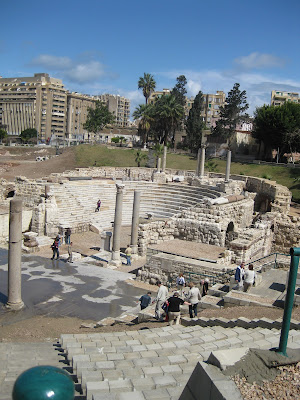Alexandria is my favorite city in Egypt. It is a center of ancient learning, and has always been sort of the equivalent of St. Petersburg-a window to the outside world. You would expect it to be the most modern of Egyptian cities and at least psychologically that is true. But in terms of the infrastructure of a modern city they have a problem. Every time they try to excavate for something new they hit stuff like this:
Ancient ruins everywhere. This is the largest archaeological site in Alexandria, if one somewhat inexcusably ignores the fascinating underwater archeology in the harbors. The big pile of red brick in the background is the remains of an extensive bath complex. The seating to the left is modern, built into a slope that is packed with shards of amphorae and samian ware. This structure is designed to allow modern day theater goers to have as a visual backdrop, this:
This is a very pretty little theater. Thirteen rows of seating survive, there were probably three more in antiquity giving a cozy venue for about 800 spectators. For this reason, and because it seems to have once had a supported roof, it would technically be more proper to refer to it as an Odeon. But since the locals insist on calling it a theater I will not be argumentative.
It dates from the 3rd century AD and appears to have stayed in operation to the end of the Byzantine era. Various sections have been rebuilt after the earthquakes common to this part of the ancient world.
In my discussion of the Odeon at Lyon I suggested that the productions presented were high brow stuff, musical performances and lectures. But some of the graffiti at the Alexandria Odeon appears to relate to political meetings, wrestling matches and to the Blues and Greens, fractious sports enthusiasts whose passions for chariot racing often boiled over to riot and mayhem. Odd that even at the heart of the ancient world's most storied center of learning there was an element of the rude proletariat.
The theater has a marvelous acoustic "sweet spot". When you stand there and speak quietly the echo comes back with perfect fidelity, giving you the disconcerting experience of having yourself whisper directly into both of your own ears!
If the Odeon proper has a surprising low brow theme directly adjacent to it are a row of structures that perhaps preserve the theme of ancient learning.
These miniature theaters are felt to be "auditoria". Basically classrooms where a teacher would stand atop a raised platform while students sat literally at the feet of the master. They date from the 5th and 6th centuries AD and suggest that the entire complex had an academic purpose at that point in history.
Who knows. If this was the classroom of ancient Alexandria perhaps the Odeon served part time as the equivalent to our college football stadium!
Addendum: A bit tattered from long use as a bookmark, here is my entry ticket for the theater complex:
Egyptian banknotes are rubbish, but their tickets are rather nice!






No comments:
Post a Comment